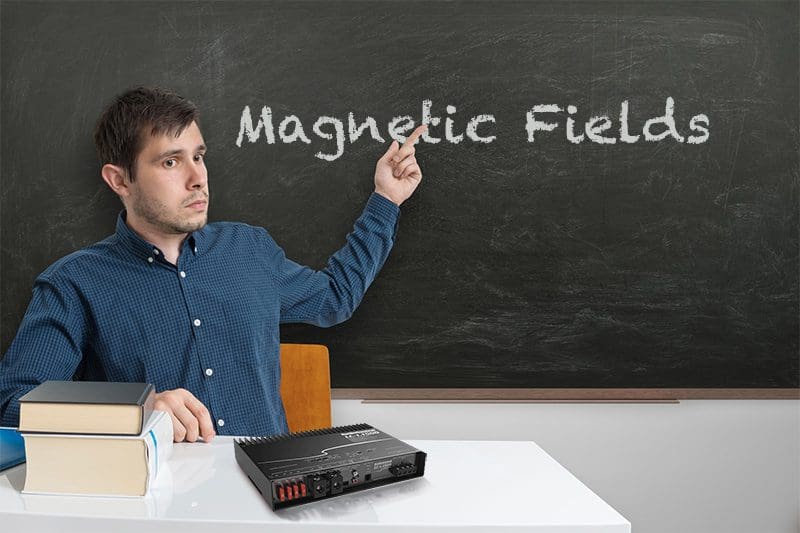 Furthering our discussion about car audio electrical theory brings us to a discussion of how the flow of electricity through a conductor creates magnetic fields around the conductor. Understanding the relationship between current flow and magnetism is crucial to understanding how a speaker works.
Furthering our discussion about car audio electrical theory brings us to a discussion of how the flow of electricity through a conductor creates magnetic fields around the conductor. Understanding the relationship between current flow and magnetism is crucial to understanding how a speaker works.
History of Electromagnetism
 The first documented correlation between electricity and magnetism came from Gian Domenico Romagnosi, a 19th-century Italian legal scholar who noticed that a magnetized needle moved in the presence of a voltaic pile (the predecessor to a battery). Hans Christian Ørsted observed a similar occurrence in April 1820. He was setting up materials for an evening lecture and noticed that a compass needle changed directions when he connected a battery to a circuit. Neither Romagnosi nor Ørsted could explain the phenomenon, but they knew there was a defined relationship.
The first documented correlation between electricity and magnetism came from Gian Domenico Romagnosi, a 19th-century Italian legal scholar who noticed that a magnetized needle moved in the presence of a voltaic pile (the predecessor to a battery). Hans Christian Ørsted observed a similar occurrence in April 1820. He was setting up materials for an evening lecture and noticed that a compass needle changed directions when he connected a battery to a circuit. Neither Romagnosi nor Ørsted could explain the phenomenon, but they knew there was a defined relationship.
In 1873, James Clark Maxwell released a publication titled A Treatise on Electricity and Magnetism, which explained the presence of four effects:
- Electric charges attract or repel one another with a force inversely proportional to the square of the distance between them: Unlike charges attract, like ones repel.
- Magnetic poles (or states of polarization at individual points) attract or repel one another in a manner similar to positive and negative charges and always exist as pairs: Every north pole is yoked to a south pole.
- An electric current inside a wire creates a corresponding circumferential magnetic field outside the wire. Its direction (clockwise or counter-clockwise) depends on the direction of the current in the wire.
- A current is induced in a loop of wire when it is moved toward or away from a magnetic field, or a magnet is moved toward or away from it; the direction of current depends on that of the movement.
What Causes a Magnetic Field when Electricity Flows?
 Electricity is the movement of electrons into and out of a conductor. One electron enters the end of a conductor, bumps into another electron, and so on until a different electron leaves the other end of the conductor and enters the load.
Electricity is the movement of electrons into and out of a conductor. One electron enters the end of a conductor, bumps into another electron, and so on until a different electron leaves the other end of the conductor and enters the load.
Because there are effectively more electrons in the conductor when current is flowing, the balance of negatively charged electrons to positively charged ions is upset and thus causes an imbalance in the magnetic field around the conductor.
We could devote thousands of words to explaining how atoms work. But in short, the core of an atom has a core of positively charged protons with a bunch of negatively charged electrons circling this core. When there is no flow of current, an atom doesn’t have a magnetic field because the quantity and path of the electrons around the protons are balanced. When we bump an electron out of an atom and into another, the atoms become imbalanced and thus produce a net magnetic field.
An Explanation On a Larger Scale
When electricity flows from the positive terminal of a battery to the negative, a magnetic field is created around the conductor. If you look at the image below, you will see the direction of the magnetic field relative to the flow of power.
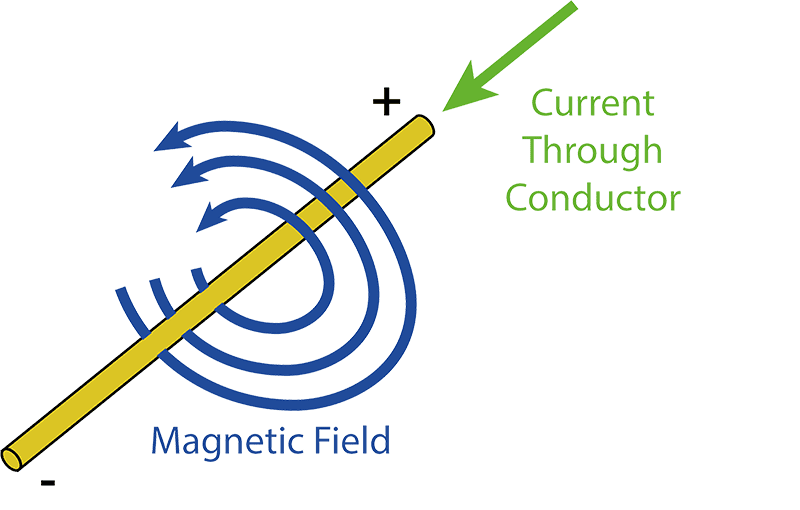
In schools, this is often referred to as the right-hand rule. If you wrap your right hand around a conductor with your thumb extended upward in the direction of current flow (putting positive below your hand and negative above), your fingers point in the direction of the magnetic field.
Keep in mind that for audio signals, the polarity of the current changes from positive to negative in the same way that the vibrations produced by someone talking or playing an instrument pressurize and rarefy the air to produce sound.
How Magnetism Makes a Speaker Work
Conventional moving coil loudspeakers use a coil of wire (called a voice coil) and a fixed magnet. The electricity from the amplifier flows through the voice coil and creates a magnetic field. The polarity of the magnetic field pulls the voice inward or pushes it out in an amount proportional to the strength of the magnetic field.
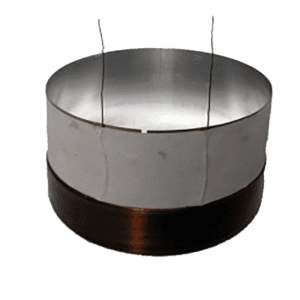
The diagram below shows the force exerted on the voice coil with the current flowing through the positive half of the audio waveform.
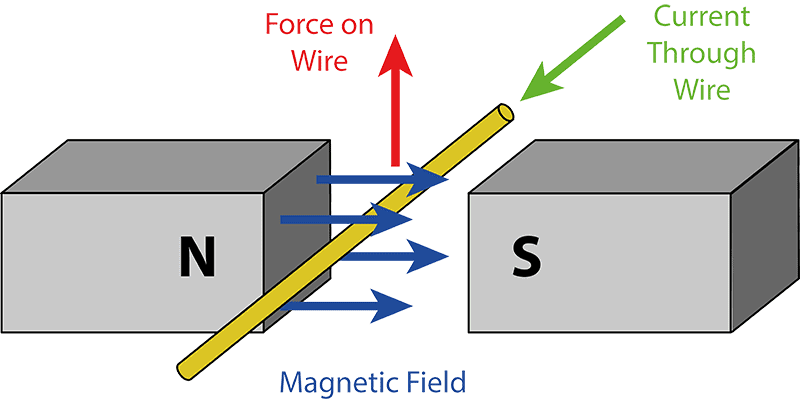
This diagram shows the force exerted on the voice coil with the current flowing through the negative half of the audio waveform.
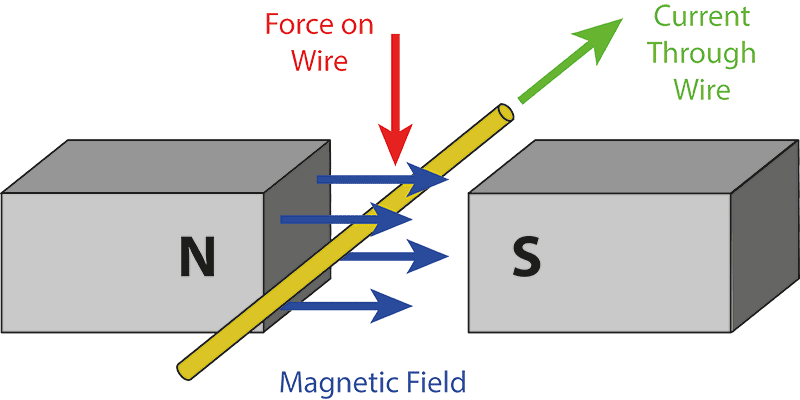
As the polarity of the current reverses, so too does the force exerted on the voice coil, which is attached to the speaker cone through the voice coil former.
Magnetism Isn’t Always Beneficial
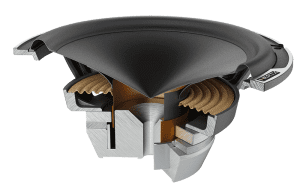 Regarding speakers, we rely on and need magnetic fields for them to work. With that said, magnetism doesn’t always work in our favor.
Regarding speakers, we rely on and need magnetic fields for them to work. With that said, magnetism doesn’t always work in our favor.
If there is a large amount of current flowing through a conductor, there will be a strong magnetic field around that conductor. If we place another conductor in that magnetic field, a voltage will be produced across the second piece of wire.
In our vehicles, many devices such as fans, sensors, the alternator, lighting control modules and computers create magnetic fields containing high-frequency noise. When an improperly shielded interconnect passes through one of these fields, it can pick up that noise and produce a voltage on the conductor. This phenomenon is why it’s important for your installer to run the interconnect cables and often the speaker wires in your car away from sources of electrical noise.
Consult Your Local Mobile Electronic Installation Experts
When it’s time to upgrade the sound system in your vehicle, visit your local specialized mobile enhancement retailer. They have the training and experience to ensure your new audio system will sound great and be free of unwanted noise!
In our next article, we are going to talk about inductance and capacitance and how those characteristics affect high-frequency electrical signals.
This article is written and produced by the team at www.BestCarAudio.com. Reproduction or use of any kind is prohibited without the express written permission of 1sixty8 media.